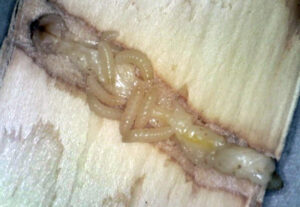By Caleb Burden, Acting Field Lead Technician, USDA APHIS PPQ;
Caleb.Burden@usda.gov or 734-732-0025

A green ash tree with a small piece of bark cut back shows emerald ash borer larvae feeding on the tree. / Photo Credit: USDA APHIS PPS
In the fight against emerald ash borer (EAB), the United States Department of Agriculture (USDA) again asks Wisconsin landowners to donate live, EAB-infested ash trees for use in a biological control program.
The emerald ash borer is an invasive insect from Asia first detected in the United States in 2002. Following its discovery, EAB has caused the death and decline of tens of millions of ash trees.
USDA aims to use the donated ash trees to rear parasitoids that attack EAB larvae. The stingless wasps (Spathius agrili and Tetrastichus planipennisi) are natural enemies of the larva, serving as predators to suppress populations. Rearing the parasitoids in donated ash trees is a crucial first step in the environmentally sound USDA biological control program, designed to preserve and protect ash as a viable part of North American landscapes.

An emerald ash borer larva is shown with several Spathius agrili parasitoid larvae feeding on it, eventually killing it. / Photo Credit: USDA APHIS PPS
Once grown, the parasitoids are released in infested areas to attack and kill EAB larvae. To date, releases have occurred in 32 states — including Wisconsin — and Washington, D.C.
Wisconsin landowners have donated infested ash trees to the USDA’s biological control program for several years. Because the USDA needs more ash trees to continue this work, the agency again hopes Wisconsin residents will consider donating infested ash trees.
“Our biological control facility in Michigan is one of a kind,” said Nicole Sawallich, acting EAB Biocontrol Facility Manager. “We rear almost a million parasitoid wasps each year and provide them at no cost to our partners for release. We’ve harvested EAB-infested ash in Michigan, Ohio and Wisconsin. And we continue to need Wisconsin’s help.”
Ideally, USDA staff is looking for live green ash stands with trees ranging from 8 to 20 inches in diameter. Trees should show significant decline, including cracked or loose bark, dead branches and thinning leaf canopies, and “flecking” damage to bark from woodpeckers feeding on EAB larvae.
The USDA is seeking potential properties in the following east central Wisconsin counties: Brown, Calumet, Kewaunee Manitowoc, Outagamie, Portage, Shawano, Waupaca, Waushara and Winnebago, along with eastern Marathon and Wood counties. The agency wants a minimum donation of 100 green ash trees per harvest site.

Several Tetrastichus planipennisi parasitoid larvae feed and develop inside emerald ash borer larvae before completing their life cycle. / Photo Credit: USDA APHIS PPS
“Right now, we are following up on leads for public land areas. They could be potential sites for our ash tree harvest,” said Caleb Burden, acting Biocontrol Field Team Leader. “We spend the summer visiting these sites to determine if the trees fit the necessary criteria. If they do, we mark them for harvest. And we (start to) harvest in mid-to-late January.”
Burden invites property owners to call him at 734-732-0025 if they want more information on donating.
“I can explain how the process works and what they can expect,” he said. “There’s no pressure in deciding. I recommend that property owners take the time to think it over. And we can work with people who have their land in (Wisconsin Department of Natural Resources) Managed Forest Law agreements.”
USDA contractors will harvest trees between January and March. There is no cost to the landowner, and workers will do their best to reduce impacts on the surrounding land.
